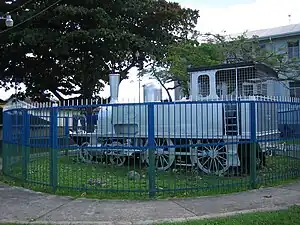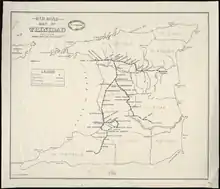Trinidad Government Railway
The Trinidad Government Railway existed between 1876 and 28 December 1968. Originally built to connect Port of Spain with Arima, the railway was extended to Couva in 1880, San Fernando in 1882, Cunapo (now Sangre Grande) in 1897, Tabaquite in 1898, Siparia in 1913 and Rio Claro in 1914.

Background

The first attempt to establish a railway was a private affair in 1846 by the Trinidad Railway Company.[1] Trinidad Railway Company's very first steam locomotive was the "Forerunner" which was built by Hunslet of Leeds and arrived in 1864.[2]
Railway construction began in the 1870s. The Arima line was completed in 1876, followed by the San Fernando line in 1882. The railway to Princes Town was completed in 1884. These were followed by railway lines to Sangre Grande in 1897 and Cunupia-Tabaquite in 1898.[3]: 14–15
Overview
At this, its greatest extent, the railway covered 173 km (107 mi).[4]
After the end of World War I, the appearance of the automobile led to changes that culminated with the phased closure of the railway April 1953 and 28 December 1968 saw the complete closure of the Trinidad Government Railways.
Statistics

The TGR appeared to have 640 route-km and was 1,435 mm (4 ft 8+1⁄2 in) standard gauge.[5]
By the end of 1921 the company owned 37 steam locomotives, 105 coaches and 738 goods wagons.[6] In 1931, a Sentinel-Cammell twin articulated steam railcar was acquired.[7] By 1936, there were 29 locomotives, 1 railcar, 82 coaches and 925 goods wagons.[8]
Stations
The principal stations, termini and junctions were:
- Port of Spain – terminus, capital and port
- Tunapuna – junction in east
- Sangre Grande – terminus in east
- Tunapuna – junction in east
- Chaguanas – junction in north central
- Couva – station in west central
- Gasparillo – station
- Princes Town – terminus
- Claxton Bay – station in south central
- Marabella – junction in south west
- San Fernando – station in south west
- Penal – station in south
- Siparia – terminus in south
New railway
On 11 April 2008 the Trinitrain consortium was chosen to plan and build two new Trinidad Rapid Railway passenger lines. This plan was cancelled in 2010.[9]
References
- "History". Public Transport Service Corporation on. Archived from the original on 10 April 2013. Retrieved 20 October 2013.
- "Real story of Engine D". Trinidad Express Newspapers on. 16 November 2014. Retrieved 26 September 2017.
- Brereton, Bridget (1979). Race Relations in Colonial Trinidad 1870–1900. Cambridge: Cambridge University Press.
- Anthony, Michael (2001). Historical Dictionary of Trinidad and Tobago. Scarecrow Press, Inc. Lanham, Md., and London. ISBN 0-8108-3173-2.
- "Railroad Gauge Width". Parovoz.com. Archived from the original on 11 January 2013. Retrieved 12 January 2010.
- "The Trinidad Government Railway - Rolling Stock and Locomotives". Commerce Reports. Washington, D.C. IV (49): 638. 3 December 1923. Retrieved 19 September 2022.
- "Locomotives of the Trinidad Government Rlys". Locomotive Magazine and Railway Carriage and Wagon Review. 42 (522): 53–55. 15 February 1936.
- World Survey of Foreign Railways. Transportation Division, Bureau of foreign and domestic commerce, Washington D.C. 1936. p. 409.
- "Trinidad rapid rail consortium confirmed". Railway Gazette International. 11 April 2008. Archived from the original on 16 June 2011.